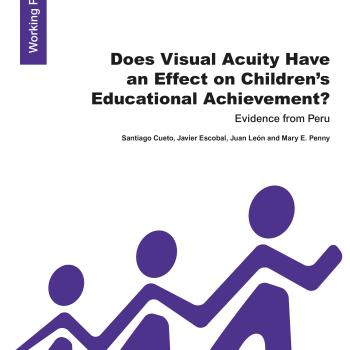
Inequity is an important issue for many international initiatives, including the current Sustainable Development Goals (SDGs). One aspect of inequity that has received little attention is the impact of disability on education. This working paper explores whether mild or moderate levels of visual impairment are associated with educational performance for 7 and 8-year-old children in Peru. Descriptive statistics from the Young Lives sample suggested that children with poorer visual acuity have better performance in mathematics, reading and vocabulary tests. However, when several characteristics of the children and their families are included as controls, the results reverse, and we found a significant negative effect of poor visual acuity on mathematics tests, marginally significant for vocabulary, and not significant for reading.
We also explored the impact for different groups of children and whether the results changed if we used categories of mild and moderate visual impairment instead of a continuous variable. We found that even marginally reduced visual acuity, just below 20/20, is associated with a lower performance in mathematics. The results outlined in this paper, along with other research in the field, support the visual screening of all schoolchildren. The final section of the paper discusses the results and policy options, including the participation of teachers in screening children for visual impairment.

Inequity is an important issue for many international initiatives, including the current Sustainable Development Goals (SDGs). One aspect of inequity that has received little attention is the impact of disability on education. This working paper explores whether mild or moderate levels of visual impairment are associated with educational performance for 7 and 8-year-old children in Peru. Descriptive statistics from the Young Lives sample suggested that children with poorer visual acuity have better performance in mathematics, reading and vocabulary tests. However, when several characteristics of the children and their families are included as controls, the results reverse, and we found a significant negative effect of poor visual acuity on mathematics tests, marginally significant for vocabulary, and not significant for reading.
We also explored the impact for different groups of children and whether the results changed if we used categories of mild and moderate visual impairment instead of a continuous variable. We found that even marginally reduced visual acuity, just below 20/20, is associated with a lower performance in mathematics. The results outlined in this paper, along with other research in the field, support the visual screening of all schoolchildren. The final section of the paper discusses the results and policy options, including the participation of teachers in screening children for visual impairment.

